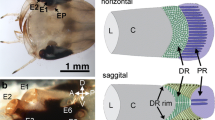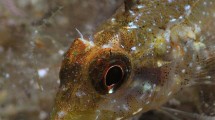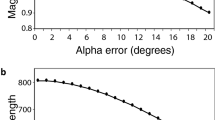Abstract
Vietnamese leaf turtles (Geoemyda spengleri) were tested for their ability to focus on prey objects at various distances. Accommodation was continuously measured by infrared photoretinoscopy. All animals investigated during this study showed a surprisingly high precision of accommodation over a range of over 30 D. Measured accommodation matched the target distance accurately for distances between 3 and 17 cm. The turtles switched between independent and coupled accommodation in the two eyes. Independent accommodation was observed when the turtles inspected their environment visually without a defined object of interest. Coupled accommodation was only observed during binocular prey fixation. When a turtle aimed at a target, the symmetrical focus of both eyes persisted even if vision was totally blocked in one eye or altered by ophthalmic lenses. This suggests that the eyes were linked by internal neuronal mechanisms. The pupil of the eye responded clearly to changes in ambient light intensity. A strong decrease in pupil size was also observed when the eye was focused on a close target. In this case, the constriction of the pupil probably aids in the deformation of the eye lens during near-accommodation.









Similar content being viewed by others

References
Ariel M (1990) Independent eye movements in the turtle. Vis Neurosci 5:29–41
Bishop PO, Pettigrew JD (1986) Neural mechanisms of binocular vision. Vision Res 26:1587–600
Bowmaker JK, Loew ER, Ott M (2000) Porphyrins and rhodopsins in chameleons, Chamaeleo dilepis and Furcifer lateralis. IOVS 41: B275
Campbell FW, Green DG (1965) Monocular versus binocular visual acuity. Nature 208:228–229
Duke-Elder S (1958) System of ophthalmology. I. The eye in evolution. Kimpton, London, pp 353–395
Franz V (1934) Vergleichende Anatomie des Wirbeltierauges. In: Bolk L, Göppert E, Kallius E, Lubosch W (eds) Handbuch der vergleichenden Anatomie der Wirbeltiere Bd. 2, Urban und Schwarzenberg, Berlin
Fritzberg W (1912) Beiträge zur Kenntnis des Akkommodationsapparates bei Reptilien. Arch Vergl Ophthalmol 3:292–322
Glickstein M, Millodot M (1970) Retinoscopy and eye size. Science 168:605–606
Granda AM, Dearworth JR, Kittila CA, Boyd WD (1995) The pupillary response to light in the turtle. Vis Neurosci 12:1127–1133
Harkness L (1977) Chameleons use accommodation cues to judge distance. Nature 267:346–349
Harkness L, Bennett-Clark HC (1978) The deep fovea as a focus indicator. Nature 272:814–816
Henze M, Schaeffel F, Ott M (2004) Variations in the off-axis refractive state in the eye of the Vietnamese leaf turtle (Geoemyda spengleri). J Comp Physiol A
Kirmse W (1988) Foveal and ambient visuomotor control in chameleons (Squamata) – experimental results and comparative review. Zool Jb Physiol 92:341–350
Kirmse W, Kirmse R, Milev E (1994) Visuomotor operation in transition from object fixation to prey shooting in chameleons. Biol Cybern 71:209–214
Kröger RH, Binder S (2000) Use of paper selectively absorbing long wavelengths to reduce the impact of educational near work on human refractive development. British J Ophthalmology 84:890–893
Kruger PB, Mathews S, Katz M, Aggarwala KR, Nowbotsing S (1997) Accommodation without feedback suggests directional signals specify ocular focus. Vision Res 37:2511–2526
Ott M (2001) Chameleons have independent eye movements but synchronise both eyes during saccadic prey tracking. Exp Brain Res 139:173–179
Ott M, Schaeffel F (1995) A negatively powered lens in the chameleon. Nature (Lond) 373:692–694
Ott M, Schaeffel F, Kirmse W (1998) Binocular vision and accommodation in prey-catching chameleons. J Comp Physiol A 182:319–330
Northmore DPM, Granda AM (1991) Refractive state, contrast sensitivity, and resolution in the freshwater turtle, Pseudemys scripta elegance, determined by visual evoked potentials. Vis Neurosci 7:619–625
Pettigrew JD, Konishi M (1976) Neurons selective for orientation and binocular disparity in the visual wulst of the barn owl (Tyto alba). Science 193:675–678
Pettigrew JD, Collin SP, Ott M (1999) Convergence of specialised behaviour, eye movements and visual optics in the sandlance (Teleostei) and the chameleon (Reptilia). Curr Biol 9:421–424
Rudloff HW (1990) Schildkröten. Urania, Leipzig
Schaeffel F, Diether S (1999) The growing eye: an autofocus system that works on very poor images. Vision Res 39:1585–1589
Schaeffel F, Mathis U (1991) Underwater vision in semi-aquatic European snakes. Naturwissenschaften 78:373–375
Schaeffel F, Wagner H (1992) Barn owls have symmetrical accommodation in both eyes, but independent pupillary responses to light. Vision Res 32:1149–1155
Schaeffel F, Howland HC, Farkas L (1986) Natural accommodation in the growing chicken. Vision Res 26:1977–1993
Schaeffel F, Wilhelm H, Zrenner E (1993) Inter-individual variability in the dynamics of natural accommodation in humans: relation to age and refractive errors. J Physiol (Lond) 461:301–320
Schaeffel F, Hagel G, Eikermann J, Collett T (1994) Lower field myopia and astigmatism in amphibians and chickens. J Opt Soc Am A 11:487–495
Schmid KL, Howland HC, Howland MJ (1992) Focusing and accommodation in tuatara (Sphenodon punctatus). J Comp Physiol A 170:263–266
Seidemann A, Schaeffel F (2002) Effects of longitudinal chromatic aberration on accommodation and emmetropization. Vision Res 42:2409–2417
Semmlow J, Stark L (1973) Pupil movements to light and accommodative stimulation: a comparative study. Vision Res 13:1087–1100
Snyder AW, Miller WH (1978) Telephoto lens system of falconiform eyes. Nature 275:127–129
Steinbach MJ, Money KE (1973) Eye movements of the owl. Vision Res 13:889–891
Ventura DF, Zana Y, De Souza JM, Devoe RD (2001) Ultraviolet colour opponency in the turtle retina. J Exp Biol 204:2527–2534
Walls GL (1942) The vertebrate eye and its adaptive radiation. Hafner, New York
Walls GL (1961) The evolutionary history of eye movements. Vision Res 2:69–80
Williams DR (1988) Topography of the foveal cone mosaic in the living human eye. Vision Res 88:433–439
Acknowledgements
We thank M. and W. Matzanke for putting their Vietnamese Leaf Turtles at our disposal to take some preliminary measures. The experiments reported in this paper comply with the Principles of Animal care, publication No. 86-23, revised 1985, of the National Institutes of Health and were carried out in accordance with the German “Tierschutzgesetz”.
Author information
Authors and Affiliations
Corresponding author
Rights and permissions
About this article
Cite this article
Henze, M.J., Schaeffel, F., Wagner, HJ. et al. Accommodation behaviour during prey capture in the vietnamese leaf turtle (Geoemyda spengleri). J Comp Physiol A 190, 139–146 (2004). https://doi.org/10.1007/s00359-003-0479-y
Received:
Revised:
Accepted:
Published:
Issue Date:
DOI: https://doi.org/10.1007/s00359-003-0479-y



